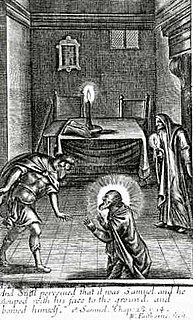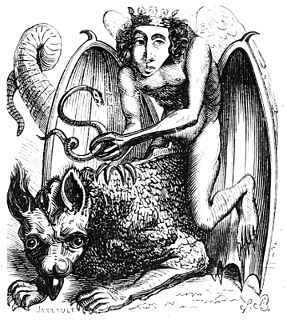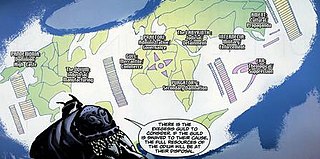
A demon is a supernatural being, typically associated with evil, prevalent historically in religion, occultism, literature, fiction, mythology, and folklore; as well as in media such as comics, video games, movies, anime, and television series.

A grimoire is a textbook of magic, typically including instructions on how to create magical objects like talismans and amulets, how to perform magical spells, charms and divination, and how to summon or invoke supernatural entities such as angels, spirits, deities, and demons. In many cases, the books themselves are believed to be imbued with magical powers, although in many cultures, other sacred texts that are not grimoires have been believed to have supernatural properties intrinsically. The only contents found in a grimoire would be information on spells, rituals, the preparation of magical tools, and lists of ingredients and their magical correspondences. In this manner, while all books on magic could be thought of as grimoires, not all magical books should be thought of as grimoires.

Necromancy is the practice of magic or black magic involving communication with the dead – either by summoning their spirits as apparitions, visions or raising them bodily – for the purpose of divination, imparting the means to foretell future events, discover hidden knowledge, to bring someone back from the dead, or to use the dead as a weapon. Sometimes referred to as "Death Magic", the term may also sometimes be used in a more general sense to refer to black magic or witchcraft.

Danzig II: Lucifuge is the second album by American heavy metal band Danzig. It was released in 1990 on Def American Recordings and was reissued in the US and UK in 1998 by Def American's successor, American Recordings.
Demonology is the study of demons or beliefs about demons, and the hierarchy of demons. They may be nonhuman, separable souls, or discarnate spirits which have never inhabited a body. A sharp distinction is often drawn between these two classes, notably by the Melanesians, several African groups, and others. The Islamic jinn, for example, are not reducible to modified human souls. At the same time these classes are frequently conceived as producing identical results, e.g. diseases.

The Grand Grimoire is a black magic grimoire. Different editions date the book to 1521, 1522 or 1421, but it was probably written in the early 19th century. Owen Davies suggests 1702 is when the first edition may have been created and a Bibliothèque bleue version of the text may have been published in 1750. The "introductory chapter" was authored by someone named Antonio Venitiana del Rabina who supposedly gathered this information from original writings of King Solomon. Much of material in this grimoire derives from the Key of Solomon and the Lesser Key of Solomon. Also known as Le Dragon Rouge or The Red Dragon, this book contains instructions purported to summon Lucifer or Lucifuge Rofocale, for the purpose of forming a Deal with the Devil. The 19th century French occultist Éliphas Lévi believed the contemporary edition of Le Dragon Rouge to be counterfeit of the true, older Grand Grimoire.

Astaroth, in demonology, is the Great Duke of Hell in the first hierarchy with Beelzebub and Lucifer; he is part of the evil trinity. He is a male figure most likely named after the Near Eastern goddess Astarte.

Bael is a demon described in demonological grimoires such as the Lesser Key of Solomon and the Pseudomonarchia Daemonum and also in the Dictionnaire Infernal. He is described as a hoarsely-voiced king with the power to make men invisible and ruling over sixty-six legions of demons. The Lesser Key of Solomon describes him as appearing in the form of a cat, toad, man, some combination thereof, or other "divers [sic] shapes", while the Pseudomonarchia Daemonum and the Dictionnaire Infernal state that he appears with the heads of a cat, toad, and human simultaneously. Jacques Collin de Plancy wonders if Bael is the same as the Canaanite deity Baal, a reasonable conclusion. In the Livre des Esperitz, Bael is described as a king ruled by Orient (Oriens), still possessing the power of invisibility, as well as the power to garner the favor of others, but ruling over only six legions of demons. The Liber Officium Spirituum features Baal, Baall, Boal, or Boall, again a hoarsely-voiced king, with not only powers of invisibility but also sciences and love. Sloane MS 3824 mentions Baal, in "Of the Demon Rulers," as a king ruled by Oriens, attributed with teaching science, (again) granting invisibility, and controlling 250 legions of spirits. Bael appears in later editions of The Grimoire of Pope Honorius, under Astaroth, as a prince whose powers include (again) invisibility and popularity. In the Grand Grimoire, Bael is listed as a subordinate of Lucifuge Rofocale. According to Rudd, Bael is opposed by the Shemhamphorasch angel Vehuiah.

In demonology, Orobas is a powerful Great Prince of Hell, having twenty legions of demons under his control.

There have been various attempts throughout time of the earth existing by theologian scholars in the classification of Christian demons for the purpose of understanding the biblical and mythological context of adversarial spirits. Theologians have written dissertations in Christian demonology, classical occultism, classical mythology and Renaissance magic to clarify the connections between these spirits and their influence in various demons. The study of demonology was historically used to understand morality, behavioral tendencies, and has even been used as symbolism to relay anecdotal tales in with which they lure people into temptation and may also include the angels or saints that were believed to have been their adversaries; an idea which derived from the Biblical battle between the Archangel Michael and the Antichrist in The Book of Revelation describing a war in heaven which resulted in Satan and his angels being expelled from Heaven. The classifications of these fallen angels are based on many other characteristics as well, such as behaviors that caused their fall from heaven, physical appearances or the methods that were used to torment people, cause maladies, or elicit dreams, emotions, etc. Most authors who wrote theological dissertations on the subject either truly believed in the existence of infernal spirits, or wrote as a philosophical guide to understanding an ancient perspective of behavior and morality in folklore and religious themes.

Many Waters is a 1986 novel by Madeleine L'Engle, part of the author's Time Quintet. The title is taken from the Song of Solomon 8:7: "Many waters cannot quench love, neither can the floods drown it. If a man were to give all his wealth for love, it would be utterly scorned."
In Lurianic Kabbalah and Hermetic Qabalah, the qliphoth/qlippoth/qlifot or kelipot, are the representation of evil or impure spiritual forces in Jewish mysticism, the polar opposites of the holy Sefirot. The realm of evil is also termed Sitra Achra in Kabbalah texts.
In some occult and similar writings, an archdemon is a spiritual entity, prominent in the infernal hierarchy as a leader of demons. Essentially, the archdemons are the evil counterparts of the archangels.
Sathariel is described in the Book of Enoch as the 17th Watcher of the 20 leaders of the 200 fallen angels. Michael Knibb believes the name to mean "Moon of God" or "Dawn of God" based on the Ge'ez copies of the Book of Enoch.
The demon Belial, or characters named for him, have appeared in many examples of modern culture. This is distinct from medieval culture and Milton where Belial was related to the character in Jewish sources.

Hell is a fictional location, an infernal Underworld utilized in various American comic book stories published by DC Comics. It is the locational antithesis of the Silver City in Heaven. The DC Comics location known as Hell is based heavily on its depiction in Abrahamic mythology. Although several versions of Hell had briefly appeared before in various other DC Comics publications in the past, the official DC Comics concept of Hell was first properly established when it was mentioned in The Saga of the Swamp Thing #25–27 and was first seen in Swamp Thing Annual #2 (1985), all of which were written by Alan Moore and illustrated by Stephen Bissette and John Totleben.

Johannes Cabal the Necromancer is a 2009 supernatural fiction and black comedy novel written by Jonathan L. Howard. It is the first book of an ongoing series chronicling the ventures of Johannes Cabal, a necromancer of some little infamy.
The Hebrew term mammon, personifying money in the New Testament, has led to many adaptations in literature, film, and popular culture.











